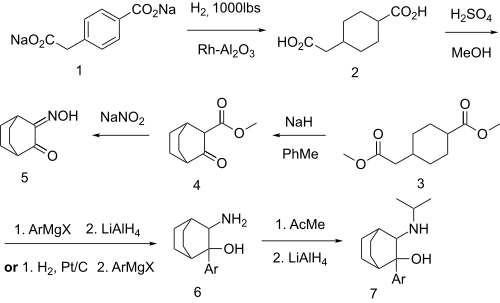Cilobamine
Source: Wikipedia, the free encyclopedia.
Chemical compound
 | |
| Clinical data | |
|---|---|
| ATC code |
|
| Identifiers | |
| |
JSmol) | |
| |
Cilobamine is a drug which acts as a
norepinephrine-dopamine reuptake inhibitor (NDRI) and has stimulant and antidepressant effects.[1][2]
It can clearly be seen that the structure is based on dichloroisoprenaline that has been fused onto the bicycloalkane scaffold.
Synthesis

An intramolecular
Dieckmann cyclization on methyl 4-(2-methoxy-2-oxoethyl)cyclohexanecarboxylate [1401222-79-4] (3) with sodium hydride base gives reaction Methyl 3-oxobicyclo[2.2.2]octane-2-carboxylate [30144-30-0] (4). Treatment with sodium nitrite introduces an isonitroso group adjacent to the ketone, giving 3-Hydroxyiminobicyclo[2.2.2]octan-2-one, CID:131066320 (5). Addition of the aryl Grignard reagent, and reduction of the oxime gives CID:154108204
(6). A reductive amination of the primary amino group with acetone then completed the synthesis of cilobamine (7).
See also
- Fencamfamine
- Manifaxine
References
- PMID 6724198.
- S2CID 145253439.
- ^ DE2003744 idem Jules Freedman, U.S. patent 3,651,142 (1970 to Colgate Palmolive Co).
| ||
|---|---|---|
SNRIs Tooltip Serotonin–norepinephrine reuptake inhibitors | ||
NRIs Tooltip Norepinephrine reuptake inhibitors | ||
NDRIs Tooltip Norepinephrine–dopamine reuptake inhibitors | ||
NaSSAs Tooltip Noradrenergic and specific serotonergic antidepressants | ||
SARIs Tooltip Serotonin antagonist and reuptake inhibitors | ||
SMS Tooltip Serotonin modulator and stimulators | ||
| Others |
| |
TCAs Tooltip Tricyclic antidepressants |
| |
|---|---|---|
TeCAs Tooltip Tetracyclic antidepressants | ||
| Others | ||
| |||||||
|
Miscellaneous | |
|---|---|
|
- #WHO-EM
- ‡Withdrawn from market
- Clinical trials:
- †Phase III
- §Never to phase III
